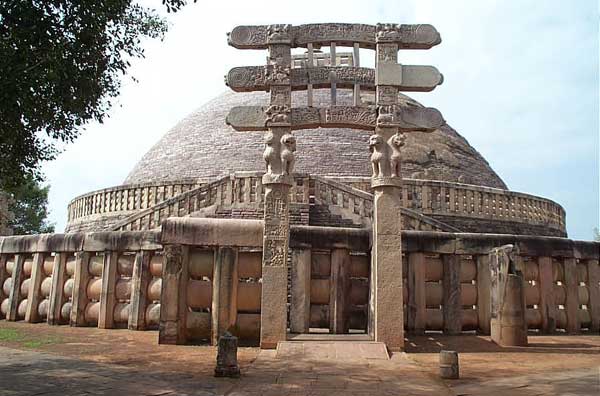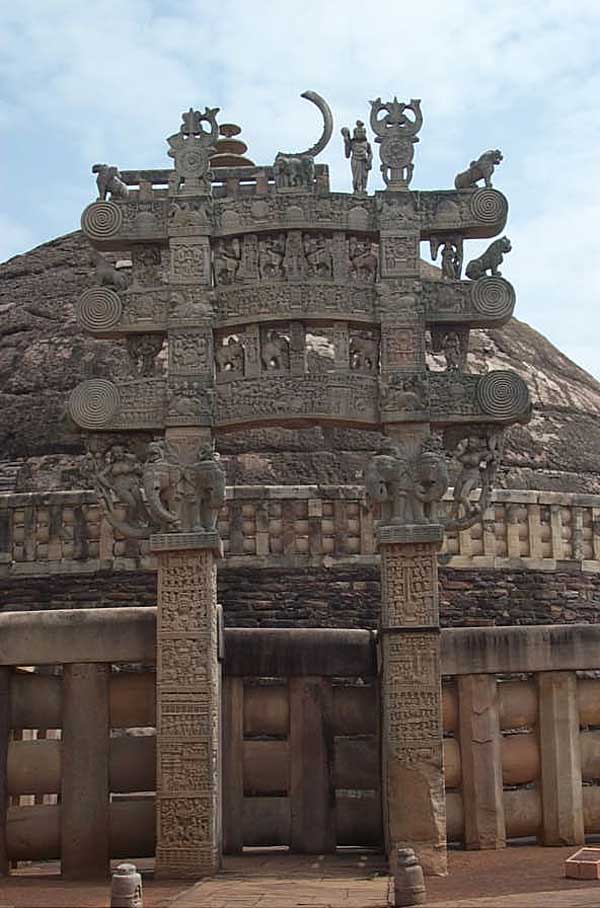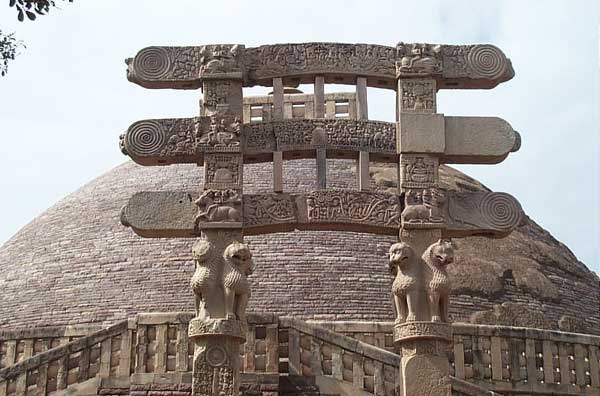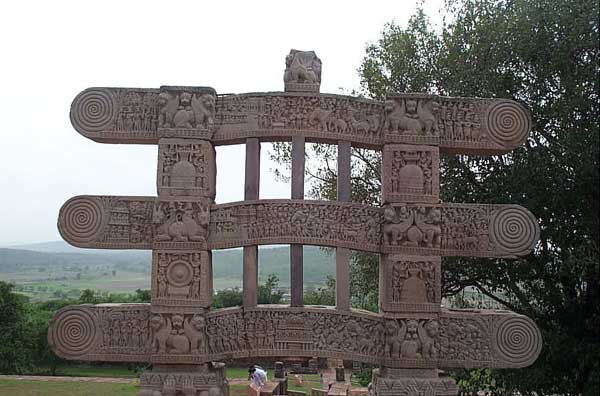
SANCHI STUPA
A. N. Maheshwari

Emperor Asoka (273-236 B.C.) built stupas in Buddha's honour at many places in India. Stupas at Sanchi are the most magnificent structures of ancient India. UNESCO has included them as one of the heritage sites of the world. Stupas are large hemispherical domes, containing a central chamber, in which the relics of the Buddha were placed. Sanchi stupas trace the development of the Buddhist architecture and sculpture at the same location beginning from the 3rd century B.C. to the 12th century A.D.
Asoka when he was a governor married Devi, the daughter of a respected citizen of Vidisha, a town 10 km from the Sanchi hill. Prince Mahendra visited Sanchi with his mother before leaving for the island of Lanka for taking Buddhism there. Emperor Asoka had put up at Sanchi a pillar edict and a stupa containing relics of the Buddha. Addition of new stupas and expressions in stone of legends around the life of the Buddha and the monastic activities at the Sanchi hill continued under several dynasties for over fifteen hundred years. Also, the Brahmi script could be deciphered from the similarities in inscriptions carved at different places in the main stupa.
Sanchi stupas are noteworthy for their gateways as they contain ornamented depiction of incidents from the life of the Buddha and his previous incarnations as Bodhisattvas described in Jataka tales. Sculptors belonging to different times tried to depict the same story by repeating figures. The Buddha has been shown symbolically in the form of tree or through other inanimate figures. One of the sects of Buddhism opposed depiction of the Buddha by a human figure.
The top of the Asoka pillar, which comprises of four lions, has been kept in the museum maintained by the Department of Archaeology. The size and the weight of the pillar point to advanced construction technology that was existent at the time of Asoka. It must have been an incredible feat of engineering to bring the stone for carving the pillar from the mine to Sanchi and installing it up the hill.
Jataka Tales
Jataka tales as do Aesop's fables teach generosity and self-abnegation based on previous lives of the Buddha as Bodhisattvas. As a Bodhisattva he took births as man, animal or bird. It is believed that the Buddha accumulated virtue by good deeds he did as Bodhisattvas and had attained merit for achieving nirvana in his last birth when he was born as the prince Siddhartha.

In this tale Bodhisattva was born as a monkey. He was the king of eighty thousand monkeys. They lived happily on a mango tree by the side of the river Ganges and ate its tasty fruits. Brahamadatta, the king of Varanasi, on knowing that the mangoes of the tree where the monkeys lived were very delicious and sweet, surrounded the mango tree with his soldiers. They started killing the monkeys with arrows. The monkey king at the risk of his life decided to save the lives of the other monkeys. He jumped across the river and found a bamboo pole. When he found that the length of the pole was not enough for crossing the river he tied one end of the bamboo pole to the mango tree and its other end to his waist. He stretched his body and made a living bridge across the river. His friends crossed to safety by using the bridge consisting of the bamboo pole and the stretched body of their king. Devadatta who was also a monkey was the rival of the monkey king. Devadatta found in this situation an easy opportunity for killing the monkey king. He jumped on him violently. The monkey king's heart ruptured out of his body. When Brahamadatta saw the supreme sacrifice of the monkey king his heart filled with sorrow. The Bodhisattva before dying gave a sermon to Brahamadatta. Brahamadatta performed the last rites of the monkey king with honour and respect.
In some of the panels on the gateways of the stupa scenes from this Jataka tale have been shown.

In one of his previous births the Bodhisattva was born as a six-tusked elephant. He lived in the Himalayas with his two female elephant wives named Chulasubhudha and Mahasubhudha . Chulsubhudha despised her husband as she thought that he loved his other wife more than her. She prayed that in her next life she may be born a beautiful girl and have the good fortune of marrying the king of Varanasi. Her deep jealousy and the desire to take revenge from her husband resulted in her death. As she had wished, she was born in her next birth a beautiful girl and became the wife of the king of Varanasi. She feinted illness and pleaded her husband to ask Sonuttar, the king's archer, to bring for her the tusks of the six-tusked elephant. The hunter wounded the six-tusked elephant with arrows and tried to pull out his tusks. The elephant took pity on the hunter and helped him in pulling out his tusks. When the tusks were given to the queen she repented her wanton act and died out of grief.
In some panels on the gateways of the main stupa scenes from this tale have been shown.

In one of his previous births the Buddha was born as the prince Vessantra. The prince was very generous. He gifted away the elephant that had supernatural power of bringing rains to the Brahmins of Kalinga, as it was undergoing drought. Vessantara's father, the king, was so upset by this gesture of his son that he ordered the prince to leave his kingdom with his wife, the son and the daughter. Vessantra drove out of his father's country in a chariot driven by four horses. As he left, he gave away the carriage and the horses for asking, and settled in a hut in the forest with his family. Soon he gave away his children to a wandering ascetic, who needed them to do begging for him. Finally, he disposed off his wife in a similar manner. But all ended happily, for those who had asked him for his most precious possessions were gods in disguise, who had decided to test his generosity. They restored to him his family and Vessantra was received back by his father.
In some of the panels on the gateways of the stupa scenes from this Jataka tale have been shown.

This Jataka tale is about the extreme devotion of the Bodhisattva Sama to his parents. Sama's parents had become blind because of snake bite. Sama devoted his life for serving his blind parents. One day when Sama was filling his pitcher with water from a river, the king of Varanasi miss took him for a deer and shot him dead with an arrow. When the king saw the pitiable condition of Sama's parents his heart filled with remorse. The sorrowful king decided to dedicate his life in taking care of Sama's parents. The lamentations of Sama's parents and the noble gesture of the king touched the heart of a goddess who witnessed this situation. The goddess with her magical powers restored the eye sight of Sama's parents and made Sama alive.
In some of the panels on the gateways of the stupa scenes from this Jataka tale have been shown.
An album of pictures from Sanchi has been put on this website. Individual pictures can be accessed from their thumbnails.
You may like to send your comments on this website and additional information on Sanchi to